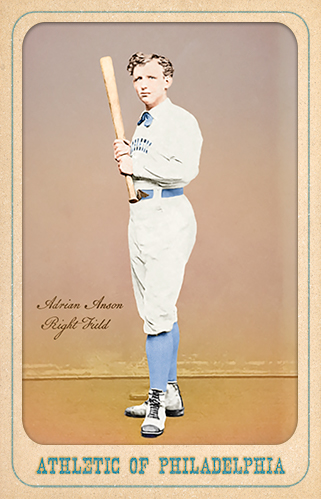
- Series: Athletic of Philadelphia: 1874
- City: Philadelphia
- Team: Athletics (NAPBBP)
- League: National Association (NAPBBP)
This cabinet is currently on the drawing board and is coming soon.
Alfred W. Gedney (1849-1922) was an outfielder for four teams over four years in the National Association of Professional Base Ball Players (NAPBBP). Gedney's tenure in the first openly professional baseball league began in 1872 with the Troy Haymakers, one of the most significant of the early clubs. The "Count" then moved down to Brooklyn’s Eckfords and then over to the New York Mutuals before joining the Philadelphia Athletics in 1874. Gedney then returned to the Mutuals for a final stint in ‘75, where it appears his professional baseball career ended with the demise of the NAPBBP and the establishment of the National League in 1876. Why Gedney did not join with his many NAPBBP compatriots and transition into the new professional league is unknown, but his below average production over his years in the NAPBBP might have been a factor.
- We may only presume that Gedney’s royal nickname derived from his debonair style and elegant handlebar mustache. Early photos depict a confident man of regal bearing, clearly to the manor born.
- In 1872 with Troy, the Count actually placed second in the league in home runs with three. Lip Pike of Lord Baltimore led the league with seven.
- Gedney’s year as an Athletic of Philadelphia was actually his best. He hit .275 and tied for 2nd on the club in RBI with 34. Cap Anson led the team with 37 and Dick McBride was the other at 34.
- For his career, the Count batted .251. He managed only two more home runs following his debut with the Haymakers, and was one of only three Athletics to homer in '74
- The Brooklyn native’s first experience in amateur ball came with the Union of Morrisania (Bronx) team in the old NABBP in 1870
- Was the 137th player to debut in MLB
- Series: Athletic of Philadelphia: 1874
- City: Philadelphia
- Team: Athletics (NAPBBP)
- League: National Association (NAPBBP)
- Hall: National Baseball Hall of Fame
Adrian Constantine Anson (1852-1922) was Mr. Longevity, a big, brawling cyclone of controversy & batsmanship unrivaled in the early days of pro ball. He set hitting standards that only the greatest future players would approach or break. He also, by dint of his ferocious personality, may have been the single greatest force for segregation in baseball until Branch Rickey began to reverse that sad estate.
- Played a record 27 consecutive years in the NL
- First batter to 3000 hits, using his powerful arms to create line drives with a short swing
- Managed the Chicago NL team to five pennants and still holds the Cub franchise records for hits, doubles, runs scored and runs batted in
- Elected to Hall of Fame: 1939

- Series: Athletic of Philadelphia: 1874
- City: Philadelphia
- Team: Athletics (NAPBBP)
- League: National Association (NAPBBP)
Weston Dickson Fisler (1841-1922) was a century too late to fire the shot heard round the world, but the Philadelphia infielder did strike the first blow in a different kind of American Revolution. On April 22, 1876, in the inaugural game of the new National League, the Boston Red Stockings (Red Caps) played Fisler’s Athletics at the Jefferson Street Grounds and Wes scored the first run. It was fitting that such a moment was shared by teams from the two cities most associated with the founding of the nation. And so it was that America celebrated its first centennial with the birth, in Philadelphia, of modern major league baseball.
Fisler grew up in neighboring Camden, N.J., the son of its mayor. At 5’6” and a mere 136 lbs, Fisler was a super-utility "tenth man" with the A’s, playing in 273 games across six seasons, mostly at 1st, 2nd & in the outfield. He had debuted in 1871, the season his team won the first and most controversial championship in the five year history of the National Association (NAPBBP). That pennant wasn’t decided until months after the season ended, when Harry Wright’s Bostons were deprived of their flag by vote of the owners at a November meeting hosted by the liquor-barons who owned the Athletics - a meeting in which their product flowed freely.
- Fisler retired after the ‘76 season with an excellent .310 average, with two HRs, and 189 RBI in his 273 games.
- Series: Athletic of Philadelphia: 1874
- City: Philadelphia
- Team: Athletics (NAPBBP)
- League: National Association (NAPBBP)
John Edgar Clapp (1851-1904) played for 8 teams and managed 6 over a 12 year span, beginning in the National Association with the Middletown Mansfields in 1872 and ending with the NY Gothams in ’83. Primarily a catcher, Clapp had a career BA of .283. With a lifetime 2,523 ABs, he struck out only 51 times.
- Was the first player-manager in major league history (1872)
- Jay Jaffe's JAWS system ranks John as the 88th best catcher in MLB history, just after Bubbles Hargrave and before Ed McFarland
- Earned the nickname “Honest John” after reporting a bookie’s attempted bribe to local police
- The 1881 bribe, in current dollars, amounted to @$119,000
- Fittingly, this Honest John entered police work after retirement from the game and died on the job in his hometown of Ithaca, NY

- Series: Athletic of Philadelphia: 1874
- City: Philadelphia
- Team: Athletics (NAPBBP)
- League: National Association (NAPBBP)
Joseph V. Battin (1853-1937) was a scrappy infielder for three National Association teams from 1871-75, remaining with the St. Louis Brown Stockings as they joined the new NL in ‘76. He began with the Cleveland Forest Citys in 1871 at the age of 17, playing just one game in the outfield. After a year off, Joe returned to pro ball with the Athletics in ‘73, again getting into only one game. He caught on the following season, managing to hit .230 for the A’s across 51 games before shipping out to St. Louis for the ‘75 campaign.
Joe's second season in St. Louis, the National League's inaugural season of 1876, was his best as he hit .300 (with a 135 OPS+) in 64 games. He slumped the next year and the Browns sent him to the Alleghenys of Pittsburgh. Joe rarely hit above .200 thereafter and would spend more time in the minors than the majors over the balance of his career.
The 1880s were a time of movement for players and even teams and leagues. But few may have had as head-spinning a season as Joe in 1885. He found himself playing for five teams, three in Waterbury, CT, and each of those in a different league! He began the season with Waterbury’s Southern New England League entry, went back out to Cleveland’s Forest Citys, now in the Western League, back to Waterbury’s Brassmen of the Connecticut State League, up to Binghamton of the New York State League, and finally back in CT with Waterbury’s Eastern League squad.
- Joe got one last shot of big league glory with the Syracuse Stars in 1890, hitting .210 in 29 games
- Battin appeared on the first Hall of Fame ballot in 1936. He received one vote from the Veteran's Committee, tying him with 22 other players including Jake Beckley, Tommy McCarthy, Bobby Wallace, Jesse Burkett, Deacon White & Tim Keefe, and surpassing Candy Cummings who received zero votes




